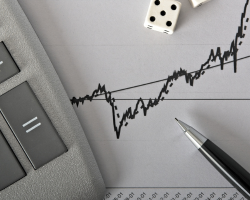A Deep Dive into 6 Technical Indicators Loved by Professionals for Confident Decision-Making

Day trading relies heavily on technical indicators, serving as the fundamental building blocks for successful trading endeavors. Proficient traders, even those within large financial institutions like Wall Street banks, universally utilize these indicators.
Yet, for new traders, these indicators may initially appear intricate and bewildering. However, the key lies not in understanding their intricate calculations but rather in mastering their optimal usage.
This article delves into some of the most effective indicators for your trading toolkit. It's essential to recognize that while we discuss specific indicators here, you have the freedom to explore and incorporate others that align with your unique trading approach.
Moreover, it's crucial to avoid the common pitfall of excessive reliance on technical indicators. Striking a balance and refraining from overuse can significantly enhance your trading acumen – a principle that holds true: less is often more.
What Is Technical Analysis?
Technical analysis stands as a method dedicated to scrutinizing chart patterns, aiming to anticipate forthcoming significant market movements. This methodology holds favor among a broad spectrum of market participants, including both investors and day traders.
A holistic application of technical analysis encompasses the utilization of various technical indicators alongside a meticulous examination of candlestick and chart patterns.
Candlestick patterns, composed of one or two candles, encompass formations such as harami, hammer, shooting star, and morning star, among others. Conversely, chart patterns unfold over an extended period and encompass configurations like cup and handle, bullish and bearish flags, head and shoulders, as well as rising and falling wedges.
This article hones in on the most effective technical indicators tailored for day trading. It's important to note that various types of indicators exist, each suited for specific analytical purposes.
To begin, there are trend indicators primarily employed in identifying trends and potential reversals. Following that, oscillators come into play, chiefly utilized for pinpointing overbought and oversold conditions.
Lastly, volume indicators shed light on the flow of volume within an asset, frequently employed by swing traders and investors. It's crucial to recognize that each indicator serves a distinct analytical purpose, catering to different trading styles and strategies.

The Most Effective Technical Indicators
Moving Averages
Among the most prevalent indicators, Moving Averages (MAs) come in three common types:
- Simple Moving Average (SMA)
- Exponential Moving Average (EMA)
- Smoothed Moving Average
The SMA involves calculating the average by summing up security prices and dividing by the number of periods. On the other hand, the EMA incorporates a multiplier to give more weight to recent prices.
An optimal approach is to utilize two MAs concurrently, commonly known as moving average crossovers. This often involves patterns such as the golden cross (indicative of an upward market trend) and the death cross (indicative of a downward market trend). Day traders often adapt these crosses to shorter timeframes, like the 25-day and 15-day averages.
Another method involves trend-following, where an asset's rising or falling nature is tracked using the preferred moving average. A potential reversal or exit point occurs when the price falls below the moving average.
Bollinger Bands
Functioning as trend indicators, Bollinger Bands consist of three lines, with the middle line being the pair's moving average, while the upper and lower bands represent standard deviations. A buy signal occurs when the price touches the lower band, and a sell signal occurs when it touches the upper band. Momentum trading involves buying when the price moves along the upper band and vice versa.
Momentum Indicator
For many traders, entering a trade and capitalizing on momentum is the primary goal. The momentum indicator aids in identifying the strength of a trend. When the price rises, the indicator moves upward, and when the downward momentum persists, the indicator moves downward.
MACD (Moving Average Convergence Divergence)
This widely-used indicator generates buy signals when the signal line crosses the MACD line in an upward direction, and sell signals when they cross heading downward. MACD, created by converting moving averages into oscillators, can also be utilized to identify divergences.
Relative Strength Index (RSI)
An oscillator indicator, RSI identifies overbought and oversold signals. An asset is considered overbought, signaling a sell opportunity, when the RSI exceeds a certain level (commonly 70). Conversely, when the RSI falls below a designated level (often 30), it suggests an oversold condition, indicating a buy opportunity. Some traders adjust these levels to 80 and 20.
Various RSI strategies exist, including buying when oversold and selling when overbought, or adopting the opposite approach based on the belief that existing momentum will persist. Divergence, similar to MACD, occurs when the price and RSI move in opposite directions.
Volume Indicator
Critical for confirming trend directions, volume indicators play a crucial role in breakout scenarios. For instance, a breakout with low volume often indicates a false breakout. Alongside these indicators, tools like Fibonacci Retracement can assist in pinpointing key entry and exit levels.
Mastering Technical Indicators: Pro Tips
Navigating through the myriad of technical indicators available in the market can be overwhelming. To employ them like a pro, consider the following three essential tips:
- Deep Understanding of Selected Indicators
Begin by acquiring a solid comprehension of the indicators you choose. While you don't necessarily need to grasp their intricate calculations, a thorough understanding of how to use them effectively is imperative. Familiarity with the nuances of each indicator enhances your ability to make informed trading decisions. - Expertise in a Select Few Indicators
Rather than attempting to conquer all available indicators, strive to become an expert in a chosen few. Many seasoned traders focus on a single indicator, such as moving averages or VWAP, while others find success with a combination of indicators like the Relative Strength Index (RSI) and the MACD. Specializing in a limited set of indicators allows for a more in-depth understanding and nuanced application. - Thorough Testing Before Live Implementation
Prior to integrating an indicator into your live trading account, conduct comprehensive testing. Utilize a demo account to master its functionality without risking your actual funds. Thorough testing not only helps you become proficient in applying the indicator but also allows you to gauge its effectiveness in various market conditions.
By adhering to these pro tips, you can harness the power of technical indicators with confidence and finesse in your trading endeavors.
Summary
In conclusion, the world of day trading is intricately woven with technical indicators, serving as indispensable tools for traders across diverse markets, from individual enthusiasts to institutional players on Wall Street. While the array of indicators may seem daunting to beginners, the key to success lies not in unraveling their complex calculations but in mastering their optimal usage.
This article has explored some of the most effective technical indicators for day trading, emphasizing the importance of understanding their roles within the broader scope of technical analysis. From moving averages and Bollinger Bands to momentum indicators like MACD and RSI, each tool serves a distinct analytical purpose, catering to various trading styles and strategies.
However, a word of caution is essential: excessive reliance on technical indicators can become a pitfall. The principle that "less is often more" holds true in the dynamic world of day trading. Striking a balance and avoiding overuse can significantly enhance trading acumen.
Moreover, technical analysis extends beyond indicators to encompass chart patterns and candlestick formations, adding depth to the analytical toolkit. Whether utilizing moving average crossovers or interpreting Bollinger Bands, traders must carefully integrate these indicators into a holistic approach that aligns with their unique trading philosophy.
To navigate the complexity of technical indicators like a seasoned pro, traders are advised to follow three key principles. First, cultivate a deep understanding of selected indicators, focusing on practical application rather than intricate calculations. Second, become an expert in a select few indicators, allowing for a more nuanced and in-depth interpretation. Finally, before deploying any indicator in live trading, conduct thorough testing in a demo account to gauge its effectiveness under various market conditions.
By embracing these pro tips, traders can confidently harness the power of technical indicators, steering their trading endeavors with finesse and informed decision-making. In the ever-evolving landscape of day trading, mastery of these tools becomes a crucial skill, empowering traders to navigate the markets with precision and confidence.

About AdroFx
Established in 2018, AdroFx is known for its high technology and its ability to deliver high-quality brokerage services in more than 200 countries around the world. AdroFx makes every effort to keep its customers satisfied and to meet all the trading needs of any trader. With the five types of trading accounts, we have all it takes to fit any traders` needs and styles. The company provides access to 115+ trading instruments, including currencies, metals, stocks, and cryptocurrencies, which make it possible to make the most out of trading on the financial markets. Considering all the above, AdroFx is the perfect variant for anyone who doesn't settle for less than the best.









